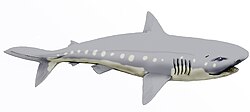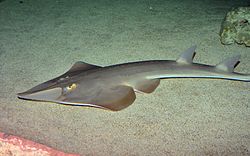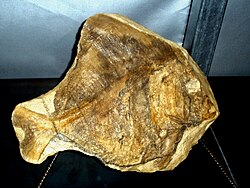Top Qs
Timeline
Chat
Perspective
Akrabou Formation
Geological formation in Morocco From Wikipedia, the free encyclopedia
Remove ads
The Akrabou Formation is a Late Cretaceous (latest Cenomanian to early/mid Turonian)-aged geological formation and Konservat-Lagerstätte in Morocco.[1] It overlies the slightly older freshwater deposits of the Kem Kem Group, which it was once thought to be a part of. It was deposited over following the Kem Kem ecosystem's submergence by the Tethys Ocean during a marine transgression from the Cenomanian-Turonian boundary event, as part of a wider deposition of carbonate platforms across the region from the event.[2][3][4]
Remove ads
Localities
Summarize
Perspective
The Akrabou Formation has outcrops across the Anti-Atlas, but it has two especially prominent localities: Agoult and Goulmima (also known as Asfla). The Agoult locality is also commonly referred to as Gara Sbaa due to it outcropping at the hill of the same name, but this name is also used for the underlying freshwater-based deposit of the Kem Kem Group at the same locality, which may lead to nomenclatural confusion.[5][6] Both localities are considered lagerstätten due to their excellently preserved fossils, but they differ in time period, paleoenvironment, and preservation of fossils.
The Agoult locality is the older of the two and appears to have been deposited around the time of the Cenomanian-Turonian boundary event, dating it to latest Cenomanian or earliest Turonian. It is a plattenkalk that contains excellently preserved two-dimensional fossils of fish, land plants, marine and terrestrial invertebrates, and some terrestrial reptiles. The presence of a significant terrestrial component indicates it was deposited in a shallow marine environment close to shore, although the deposits record the gradual deepening of the habitat as the sea level rose.[7]
In contrast, the Goulmima locality is younger, dating to the early or mid Turonian, and appears to have been deposited in an offshore environment on the continental shelf. Fossils from this locality, which include fish and marine reptiles, are found in concretions and have a unique three-dimensional preservation akin to that of the older Santana Formation in Brazil.[7][8]
In addition, several other localities are also known, some of which cross the border into Algeria, which have a rich fauna of ammonites and nautiloids.[9]
Remove ads
Paleoenvironment
In the basal Agoult horizons of the formation, a number of plant remains are known, which are similar to those found in southern Europe at the same time, suggesting floristic exchanges between northern Africa and southern Europe. Based on these, the paleoclimate of the ecosystem, at least earlier during its deposition, is suggested to have been a mildly dry subtropical climate akin to that of the modern western Canary Islands.[6][7]
Remove ads
Paleobiota
Summarize
Perspective
Color key
|
Notes Uncertain or tentative taxa are in small text; |
Most fish are documented in a species list from Amalfitano et al (2020) & Cooper et al (2023):[10]
Vertebrates
Cartilaginous fish
Bony fish
Reptiles
Mollusks
Based on Kennedy et al (2008) & Meister et al (2017):[28][9]
Arthropods
Partially based on Garassino, Angeli & Pasini (2014):[29]
Plants
Based primarily on Krassilov & Bacchia (2013):[6]
Remove ads
References
Wikiwand - on
Seamless Wikipedia browsing. On steroids.
Remove ads













































